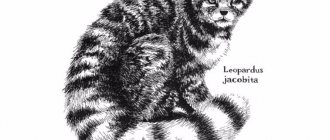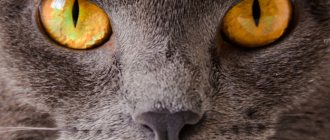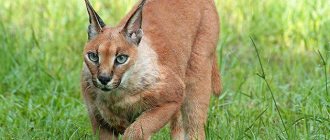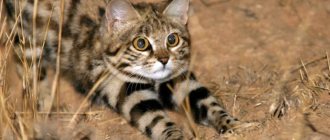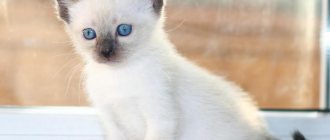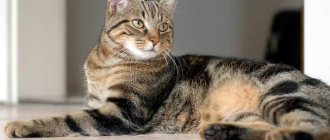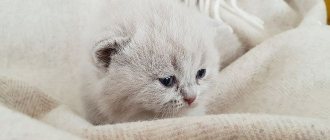Owners of exotic pets are accustomed to keeping wild cats in their homes. Usually chosen from large representatives of the cat family such as cheetahs, ocelots or servals. But there is another interesting specimen - a rusty cat. It looks like homemade ones, but upon closer examination you can see that they are very different.
Description of the breed
Representatives of the breed received their name for their peculiar, specific color - on their short gray fur there are numerous red spots reminiscent of rust. The rusty cat is native to Indonesia.
By nature, these animals are predators; they obtain food mainly by hunting insects. It is problematic for them to cope with larger prey due to their small size, because the weight category of adult individuals is no more than 1 kg.
This animal is beautiful and graceful, has a muscular body , a fluffy tail and expressive eyes of an unusual greenish-yellow color.
There are two known subspecies of the rusty cat:
- Inhabiting the region of Sri Lanka. They have a specific rich ocher color with a blurry pattern.
- Living in Indonesia. They have short gray fur with large rusty spots located mainly in the head, chest and shoulder girdle.
Manul
- Length (with tail): up to 96 cm.
- Weight: up to 5 kg.
These felines often appear very sullen. Found throughout a vast area of Central Asia, Pallas's cats (Felis manul) have short ears and furry faces that give them a perpetually irritable appearance. This corresponds to their temperament - like many other small cats, manuls are mainly solitary hunters who wait in ambush for a long time until an unwary bird comes within jumping distance of them. Unfortunately, these plump cats are endangered due to open hunting and environmental pollution.
Behavior and characteristics of hunting
Rusty cats are nocturnal predators. Representatives of this breed look for their prey on the ground and always try to stay near trees so that if danger approaches, they can climb them. Animals are excellent steeplejacks, distinguished by their agility, dexterity and speed of reactions.
Excellent vision and acute, subtle hearing help animals both in hunting and in self-defense, when it is necessary to hide from dogs, people or larger predators. The unusual coat color makes it easy to camouflage in its natural habitat.
The diet of rusty cats, in addition to insects, can include frogs, small birds and rodents. These animals and plant foods are consumed, although it constitutes only a small percentage of the daily diet.
Diet of a rusty cat
The rusty cat feeds on small mammals and birds. There are also known cases of her attacking poultry. Locals report that this elusive cat emerges after heavy rains to feed on rodents and frogs that come to the surface.
The Sri Lankan subspecies of the rusty-spotted cat (Prionailurus rubiginosus phillipsi) eats birds and mammals and also occasionally takes poultry.
In captivity, the menu is not much different. An adult animal of this species at the Frankfurt Zoo is fed daily a diet consisting of large and small pieces of beef meat, beef heart, two day-old chicks, one mouse and 2.5 grams of carrots, apples, boiled egg or cooked rice. At the zoo, animals are given daily mineral supplements, weekly multivitamins, and vitamins K and B are added to the diet twice a week. Rusty cats are sometimes fed banana, wheat germ, or fish.
This is interesting! There is a known case where an adult male in a zoo killed a rabbit weighing 1.77 kg. The cat at that time weighed only 1.6 kg, and on the night after the murder she ate another 320 grams of meat.
Wild-caught kittens at the zoo were fed a protein-rich puree and mice. Rats and minced beef with heart were also added to the diet.
Return to content
Character and temperament
Despite its small stature, it should be remembered that the rusty cat is a wild and predatory animal. By nature they are cautious, independent, secretive and self-sufficient. In nature, these animals communicate even with their fellow tribesmen only for the purpose of reproduction, during certain time periods.
If there is potential danger, the animal can become quite aggressive. At the same time, his good adaptive abilities and sharp mind are noted. A cat at a young age adapts well to living at home.
In the absence of a threat, the need to obtain food and self-defense, it becomes calm and friendly. Rusty cats are active and playful and are great with children. They become tamed very quickly and learn good manners, including going to the cat litter box.
If desired, the rusty cat can even be taught certain tricks and commands. But we should not forget about the innate hunting instinct. You should not keep your cat together with birds, rodents, or small pets.
In addition, representatives of this breed, despite their tolerant and friendly attitude towards people, most likely will not tolerate strangers or other animals on their territory.
Main breeds of small cats living at home
People often like to keep miniature animals at home. For a small pet, the apartment will be like a huge world. A small cat creates comfort and a cozy atmosphere in the house. These tiny pets will always relieve nervous tension and calm their owners.
The smallest domestic cats:
- Singaporean.
- Balinese.
- Kinkaloe.
- Dwelf breed.
- Skookum.
- Lemkin.
- Napoleon.
- Munchkin cat.
- Skif-tay-don.
- Devon Rex.
Singaporean, Balinese and Kinkaloo
The Singapura cat has short, silky, dark brown fur. The cats weigh about two kilograms, and males about three. Singapuras have a muscular body.
The owners do not experience any problems during the maintenance process, since the pets are very clean. Cats take very good care of their little kittens.
The Balinese cat is a long-haired breed bred in America. They are very affectionate and love children. Balinese women love to play even when they become adult animals.
She happily runs after a sunbeam or rustles a candy wrapper. These cats are accustomed to living in an apartment and need constant care and attention.
Another smallest breed is Kinkaloo . Outwardly they resemble a toy. They are playful and very active.
Kinkaloo's weight can reach 1600 grams, and cats weigh almost twice as much. There are no more than 100 representatives of this breed in the world.
Breed Dwelf, Skookum and Lemkin
Dwelf breeds in the world . It appeared as a result of long and painstaking selection work. Their weight is no more than 2000 grams.
These hairless creatures combine three breeds at once: Sphinx, Munchkin, American Curl. Since Dwelfs do not have fur, they are very afraid of the cold. Therefore, they need to be protected from hypothermia.
Due to frequent illnesses, they require careful personal care. Caring for the skin of these animals is very simple. You just need to wipe the skin with a special lotion or bathe with mild baby shampoo.
The Skookum breed was developed by crossing a Munchkin and a La Perm. Their weight reaches 3900 grams. Despite their short legs, they have very high mobility and high running speed.
Skookums are absolutely non-conflict dwellers of apartments. They love small children very much, but they do not like to be held by their owners. They feel more comfortable being nearby. These animals are distinguished by excellent health.
Another breed is called Lemkin . A distinctive feature is their curly coat. If you get such a cat, you will need to comb its fur very carefully and bathe it with a special shampoo.
The weight of cats reaches 2200 grams, and males weigh about four kilograms. Diseases are common to all such breeds.
Napoleon and Munchkin
Napoleon is the smallest breed of domestic cat . The weight of an adult animal is about 2500 grams, and cats are twice as heavy. This breed was created by crossing Munchkins and Persian cats.
They were bred in the USA and named after the famous French commander, who was also short.
Kitties look like small and fluffy lumps . Grooming is very labor intensive. These animals have a calm and affectionate character.
They love to sit in the arms of their owners. A sedentary lifestyle can lead to heart problems in adults.
Munchkin cats have very short legs, which are half as long as regular ones. Munchkins have an elongated body, so they are often compared to Dachshund dogs. Due to their body structure, they often have diseases of the spine, which results in heart and lung diseases.
Since Munchkins have short legs, when falling from a height they do not have time to group themselves and injuries often occur. Therefore, you need to monitor them and prevent falls. It is recommended to use a litter tray with low sides.
Many breeds were formed by crossing Munchkins with other breeds. The Minskin is just one of these breeds. It was created by crossing the Canadian Sphynx breed with the Munchkin breed. This breed is hairless and only has a little fluff on its paws. This gave rise to calling cats hobbits, in honor of fairy-tale characters.
Minskin weighs about two kilograms . They are very attached to their owners, curious and charming. If there are cats and dogs in the apartment, then Minskins get along wonderfully with both. For relaxation, they choose some enclosed space for themselves. Cats of this breed need to be bathed frequently, preferably with baby shampoo. They are unpretentious in food.
What to feed
Specialized food, even premium food, is completely unsuitable for rusty cats. These animals need exclusively natural protein food.
The basis of their diet should be meat and fish (and the meat should be raw).
You can supplement your pet’s menu with a small amount of greens, boiled eggs, and fermented milk products. It is recommended to add special vitamin and mineral supplements to the diet. These pets are fed, just like other domestic cats, 2 times a day, in the morning and evening hours.
The main meal should be shortly before going to bed, since by nature these animals are nocturnal and go in search of food precisely under the cover of darkness.
Care and maintenance
The rusty cat is not too whimsical in everyday life and does not require much attention. But there are certain nuances regarding its content that potential owners need to take into account:
- Sufficient amount of free space. It is best to keep a rusty cat outside the city, in spacious enclosures close to its natural habitat. Such an animal is not very suitable for an apartment. In this case, you will have to walk your pet regularly.
- Physical activity is vital for these predatory animals. But given comfortable conditions and no need to make efforts to obtain food, they can become lazy and lethargic, which negatively affects their health. Therefore, owners of a rusty cat should have enough time for walks and active games with their pet.
- Rusty cats at home usually change their biorhythms and lifestyle to a daytime one. Nevertheless, the animal can be active at night, and you also need to be prepared for this.
- In captivity, offspring of rusty cats appear extremely rarely; such cases are rather the exception to the rule.
In general, caring for a rusty cat is no different from caring for other pets. Every few months the animal must be bathed and combed, taking into account short hair - once every 1.5-2 weeks.
Regularly inspect your eyes and ears, treating and cleaning them of dirt. It is important to carry out antiparasitic treatment twice a year. Preventative veterinary examinations are required periodically.
Find out what other breeds of wild cats exist:
- Sumatran cat;
- kao-mani;
- clouded leopard.
Jaguarundi
- Length (with tail): up to 137 cm.
- Weight: up to 9 kg.
Despite their size, jaguarundis (Puma yagouaroundi) are closely related to large wild cats. Genetic studies indicate that this cat's ancestors arrived in the Americas sometime between 8 and 8.5 million years ago. This ancient species led to the explosive spread of cats in the New World.
The closest relatives of the jaguarundi are pumas. However, at first glance, the family connection is not so obvious. Found in grasslands and forests from Texas to Argentina, jaguarundis reach only 80 cm in length and are rusty red or gray in color.
Health
Rusty cats are very strong, resilient and stress-resistant, and have a strong immune system. They are not prone to hereditary or genetic diseases. Malaise can only be caused by insufficient exercise and poor diet.
In addition, in artificial conditions, the animal’s immunity weakens somewhat, so it must be vaccinated, following the schedule established by the veterinarian.
With proper maintenance and care, the average life expectancy of an animal is about 12 years.
Security
Rusty cats are quite rare animals. According to experts, the number of representatives of this breed today is about 10 thousand and is constantly decreasing.
The cause of extinction is considered to be poaching, problems with food, and the increased vulnerability of the miniature animal from other predators. Hunting for a rusty cat is prohibited, and the breed is listed in the Red Book.
Rusty cats are beautiful, smart, have good health and a balanced character. It is precisely because of these qualities that these small predators can easily adapt to home conditions. Natural food and a sufficient amount of free space are the main things needed to maintain their physical shape. However, people rarely get such pets due to the high cost.
A rare rusty cat in nature can cost several thousand dollars.
